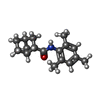+ Open data
Open data
- Basic information
Basic information
| Entry | Database: PDB / ID: 7vnr | ||||||
|---|---|---|---|---|---|---|---|
| Title | Structure of human KCNQ4-ML213 complex in digitonin | ||||||
 Components Components |
| ||||||
 Keywords Keywords | MEMBRANE PROTEIN / KCNQ4 / ML213 / cryo-EM / digitonin | ||||||
| Function / homology |  Function and homology information Function and homology informationtransporter inhibitor activity / Voltage gated Potassium channels / establishment of protein localization to mitochondrial membrane / type 3 metabotropic glutamate receptor binding / Sensory processing of sound by outer hair cells of the cochlea / Sensory processing of sound by inner hair cells of the cochlea / inner ear morphogenesis / response to corticosterone / negative regulation of high voltage-gated calcium channel activity / negative regulation of calcium ion export across plasma membrane ...transporter inhibitor activity / Voltage gated Potassium channels / establishment of protein localization to mitochondrial membrane / type 3 metabotropic glutamate receptor binding / Sensory processing of sound by outer hair cells of the cochlea / Sensory processing of sound by inner hair cells of the cochlea / inner ear morphogenesis / response to corticosterone / negative regulation of high voltage-gated calcium channel activity / negative regulation of calcium ion export across plasma membrane / regulation of cardiac muscle cell action potential / presynaptic endocytosis / nitric-oxide synthase binding / regulation of cell communication by electrical coupling involved in cardiac conduction / regulation of synaptic vesicle exocytosis / calcineurin-mediated signaling / adenylate cyclase binding / protein phosphatase activator activity / carbohydrate transmembrane transporter activity / maltose binding / voltage-gated potassium channel activity / detection of calcium ion / maltose transport / regulation of synaptic vesicle endocytosis / maltodextrin transmembrane transport / regulation of cardiac muscle contraction / potassium channel activity / catalytic complex / postsynaptic cytosol / regulation of cardiac muscle contraction by regulation of the release of sequestered calcium ion / phosphatidylinositol 3-kinase binding / presynaptic cytosol / ATP-binding cassette (ABC) transporter complex, substrate-binding subunit-containing / regulation of release of sequestered calcium ion into cytosol by sarcoplasmic reticulum / titin binding / sperm midpiece / regulation of calcium-mediated signaling / voltage-gated potassium channel complex / potassium ion transmembrane transport / calcium channel complex / substantia nigra development / regulation of heart rate / basal plasma membrane / response to amphetamine / calyx of Held / adenylate cyclase activator activity / sarcomere / protein serine/threonine kinase activator activity / nitric-oxide synthase regulator activity / regulation of cytokinesis / spindle microtubule / calcium channel regulator activity / sensory perception of sound / response to calcium ion / potassium ion transport / mitochondrial membrane / G2/M transition of mitotic cell cycle / Schaffer collateral - CA1 synapse / long-term synaptic potentiation / spindle pole / calcium-dependent protein binding / synaptic vesicle membrane / myelin sheath / outer membrane-bounded periplasmic space / growth cone / vesicle / transmembrane transporter binding / G protein-coupled receptor signaling pathway / protein domain specific binding / calcium ion binding / centrosome / protein kinase binding / protein-containing complex / nucleus / plasma membrane / cytoplasm Similarity search - Function | ||||||
| Biological species |  Homo sapiens (human) Homo sapiens (human) | ||||||
| Method | ELECTRON MICROSCOPY / single particle reconstruction / cryo EM / Resolution: 2.8 Å | ||||||
 Authors Authors | Xu, F. / Zheng, Y. | ||||||
| Funding support |  China, 1items China, 1items
| ||||||
 Citation Citation |  Journal: Neuron / Year: 2022 Journal: Neuron / Year: 2022Title: Structural insights into the lipid and ligand regulation of a human neuronal KCNQ channel. Authors: You Zheng / Heng Liu / Yuxin Chen / Shaowei Dong / Fang Wang / Shengyi Wang / Geng-Lin Li / Yilai Shu / Fei Xu /  Abstract: The KCNQ family (KCNQ1-KCNQ5) of voltage-gated potassium channels plays critical roles in many physiological and pathological processes. It is known that the channel opening of all KCNQs relies on ...The KCNQ family (KCNQ1-KCNQ5) of voltage-gated potassium channels plays critical roles in many physiological and pathological processes. It is known that the channel opening of all KCNQs relies on the signaling lipid molecule phosphatidylinositol 4,5-bisphosphate (PIP2). However, the molecular mechanism of PIP2 in modulating the opening of the four neuronal KCNQ channels (KCNQ2-KCNQ5), which are essential for regulating neuronal excitability, remains largely elusive. Here, we report the cryoelectron microscopy (cryo-EM) structures of human KCNQ4 determined in complex with the activator ML213 in the absence or presence of PIP2. Two PIP2 molecules are identified in the open-state structure of KCNQ4, which act as a bridge to couple the voltage-sensing domain (VSD) and pore domain (PD) of KCNQ4 leading to the channel opening. Our findings reveal the binding sites and activation mechanisms of ML213 and PIP2 for neuronal KCNQ channels, providing a framework for therapeutic intervention targeting on these important channels. | ||||||
| History |
|
- Structure visualization
Structure visualization
| Movie |
 Movie viewer Movie viewer |
|---|---|
| Structure viewer | Molecule:  Molmil Molmil Jmol/JSmol Jmol/JSmol |
- Downloads & links
Downloads & links
- Download
Download
| PDBx/mmCIF format |  7vnr.cif.gz 7vnr.cif.gz | 409.5 KB | Display |  PDBx/mmCIF format PDBx/mmCIF format |
|---|---|---|---|---|
| PDB format |  pdb7vnr.ent.gz pdb7vnr.ent.gz | 302.7 KB | Display |  PDB format PDB format |
| PDBx/mmJSON format |  7vnr.json.gz 7vnr.json.gz | Tree view |  PDBx/mmJSON format PDBx/mmJSON format | |
| Others |  Other downloads Other downloads |
-Validation report
| Summary document |  7vnr_validation.pdf.gz 7vnr_validation.pdf.gz | 1.2 MB | Display |  wwPDB validaton report wwPDB validaton report |
|---|---|---|---|---|
| Full document |  7vnr_full_validation.pdf.gz 7vnr_full_validation.pdf.gz | 1.2 MB | Display | |
| Data in XML |  7vnr_validation.xml.gz 7vnr_validation.xml.gz | 57.1 KB | Display | |
| Data in CIF |  7vnr_validation.cif.gz 7vnr_validation.cif.gz | 80.1 KB | Display | |
| Arichive directory |  https://data.pdbj.org/pub/pdb/validation_reports/vn/7vnr https://data.pdbj.org/pub/pdb/validation_reports/vn/7vnr ftp://data.pdbj.org/pub/pdb/validation_reports/vn/7vnr ftp://data.pdbj.org/pub/pdb/validation_reports/vn/7vnr | HTTPS FTP |
-Related structure data
| Related structure data |  32046MC  7vnpC  7vnqC M: map data used to model this data C: citing same article ( |
|---|---|
| Similar structure data |
- Links
Links
- Assembly
Assembly
| Deposited unit | 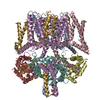
|
|---|---|
| 1 |
|
- Components
Components
| #1: Protein | Mass: 116541.383 Da / Num. of mol.: 4 Source method: isolated from a genetically manipulated source Details: The fusion protein of Potassium voltage-gated channel subfamily KQT member 4, linker, and Maltodextrin-binding protein Source: (gene. exp.)  Homo sapiens (human), (gene. exp.) Homo sapiens (human), (gene. exp.)  Gene: KCNQ4, ECBD_4002 / Strain: B / BL21-DE3 / Production host:  Homo sapiens (human) / References: UniProt: P56696, UniProt: A0A140NCD0 Homo sapiens (human) / References: UniProt: P56696, UniProt: A0A140NCD0#2: Protein | Mass: 16852.545 Da / Num. of mol.: 4 Source method: isolated from a genetically manipulated source Source: (gene. exp.)  Homo sapiens (human) / Gene: CALM3, CALML2, CAM3, CAMC, CAMIII / Production host: Homo sapiens (human) / Gene: CALM3, CALML2, CAM3, CAMC, CAMIII / Production host:  Homo sapiens (human) / References: UniProt: P0DP25 Homo sapiens (human) / References: UniProt: P0DP25#3: Chemical | ChemComp-7YV / ( #4: Chemical | Has ligand of interest | Y | |
|---|
-Experimental details
-Experiment
| Experiment | Method: ELECTRON MICROSCOPY |
|---|---|
| EM experiment | Aggregation state: PARTICLE / 3D reconstruction method: single particle reconstruction |
- Sample preparation
Sample preparation
| Component | Name: KCNQ4-ML213 complex in digitonin / Type: COMPLEX / Entity ID: #1-#2 / Source: RECOMBINANT |
|---|---|
| Source (natural) | Organism:  Homo sapiens (human) Homo sapiens (human) |
| Source (recombinant) | Organism:  Homo sapiens (human) Homo sapiens (human) |
| Buffer solution | pH: 7.4 |
| Specimen | Conc.: 4.8 mg/ml / Embedding applied: NO / Shadowing applied: NO / Staining applied: NO / Vitrification applied: YES |
| Specimen support | Grid material: GOLD / Grid mesh size: 300 divisions/in. / Grid type: Quantifoil R1.2/1.3 |
| Vitrification | Cryogen name: ETHANE |
- Electron microscopy imaging
Electron microscopy imaging
| Experimental equipment |  Model: Titan Krios / Image courtesy: FEI Company |
|---|---|
| Microscopy | Model: FEI TITAN KRIOS |
| Electron gun | Electron source:  FIELD EMISSION GUN / Accelerating voltage: 300 kV / Illumination mode: FLOOD BEAM FIELD EMISSION GUN / Accelerating voltage: 300 kV / Illumination mode: FLOOD BEAM |
| Electron lens | Mode: DARK FIELD |
| Image recording | Electron dose: 16.8 e/Å2 / Film or detector model: GATAN K3 (6k x 4k) |
- Processing
Processing
| CTF correction | Type: PHASE FLIPPING AND AMPLITUDE CORRECTION |
|---|---|
| 3D reconstruction | Resolution: 2.8 Å / Resolution method: FSC 0.143 CUT-OFF / Num. of particles: 126225 / Symmetry type: POINT |
 Movie
Movie Controller
Controller





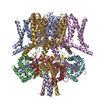


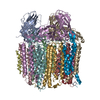
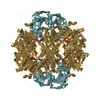
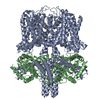


 PDBj
PDBj




